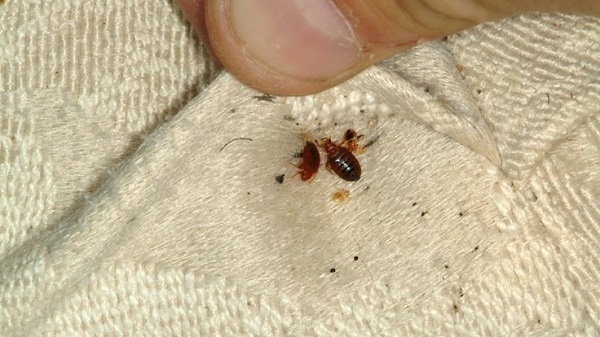Professional Bed Bug Exterminator Near Me: DC Exterminator Services
Wiki Article
Checking Out the Scientific Research Behind Bed Pest Warmth Treatments as a Sustainable Parasite Administration Method
In the world of pest administration, the mission for lasting and reliable options remains a consistent pursuit. One such method that has obtained grip in the last few years is using heat treatments to battle bed bug invasions. By utilizing the scientific research behind thermal fatality points for these persistent parasites, heat therapies offer an appealing choice to standard chemical-based strategies. The intricacies of how warmth effectively gets rid of bed pests and the wider ramifications for sustainable bug management methods make this a subject worth checking out additionally.Bed Bug Warmth Therapy Refine

Thermal Death Point for Bed Bugs
Revealing bed bugs to raised temperatures beyond their thermal tolerance range is essential for accomplishing effective obliteration in heat treatment processes. The thermal death point for bed insects refers to the temperature level at which these parasites can not make it through. Research suggests that bed pests begin to perish when revealed to temperatures above 113 ° F(45 ° C) for a continual period. As the temperature boosts, so does the mortality price of bed insects. At around 118 ° F(48 ° C ), bed insects begin to die rapidly, with a mortality rate of nearly 99% within minutes of exposure. This demonstrates the sensitivity of bed insects to heats and highlights the effectiveness of heat therapies in removing problems. By reaching and preserving temperatures over the thermal death factor for bed insects, parasite administration professionals can guarantee thorough removal of bed insect populations, including hard-to-reach locations where chemical therapies might be much less reliable. Recognizing the thermal death point for bed bugs is important for applying effective warm treatment techniques and accomplishing lasting parasite monitoring outcomes.Benefits of Warm Treatments
Having developed the critical thermal death point for bed pests, it is crucial to now discover the significant benefits that heat therapies use in efficiently removing these resistant parasites. When compared to conventional chemical techniques, warm treatments existing a number of essential benefits. Among the main advantages is that heat can permeate deep right into splits and crevices where bed insects conceal, making sure that even one of the most hard-to-reach locations are heated up to deadly temperature levels. This comprehensive approach not just eliminates online insects however also targets bed insect eggs, protecting against future infestations.Moreover, heat therapies are safe and environmentally friendly, making them a sustainable pest monitoring technique. Unlike chemical pesticides, warmth therapies do not leave harmful deposits that can posture risks to human health or the environment. This aspect is especially vital in delicate atmospheres such as health centers, colleges, and suburbs where chemical usage might not be desirable.
Furthermore, heat treatments have a high success price in removing bed pest problems in a single therapy, minimizing the need for multiple sees and reducing disturbance to passengers. This efficiency not just conserves time and cash but also provides assurance to those handling bed insect issues.
Effectiveness of Warm Treatment

Warm treatments have actually the included advantage of eliminating bed bug eggs, which are frequently resistant to standard chemical treatments. On the whole, the efficiency of heat treatments in eradicating bed insect problems makes them a lasting and reliable parasite management method.
Lasting Parasite Administration Conveniences
Executing try this out lasting pest monitoring methods offers lasting advantages for both the environment and public wellness. By utilizing techniques such as warm therapies for bug control, we can reduce the dependence on dangerous chemical pesticides that can have adverse effects on ecosystems and human health and wellness - DC exterminator. Lasting pest monitoring methods help in protecting biodiversity by targeting details bugs without hurting non-target microorganisms, therefore preserving a balanced community
Furthermore, lasting pest monitoring practices contribute to the total health and wellness and well-being of the public. By minimizing exposure to hazardous chemicals utilized in standard bug control approaches, heat treatments offer a more secure choice for parasite administration in domestic, industrial, and public areas. This reduction in chemical use additionally aids in stopping pesticide residues from polluting water, dirt, and air, protecting environmental quality.
Verdict
To conclude, bed insect heat therapies have been shown to be a effective and lasting parasite management strategy. The thermal death point for bed insects makes them at risk to heat therapies, which have many benefits over standard chemical therapies. The effectiveness of warmth therapies in eliminating bed insect invasions while lessening ecological impact highlights the possibility of this approach as a lasting service for insect control.The bed pest warmth treatment procedure involves increasing the temperature level within infested areas to a level that properly removes bed bugs and their eggs. By page reaching and maintaining temperature levels over the thermal death factor for bed insects, parasite administration specialists can make certain extensive removal of bed pest populaces, consisting of hard-to-reach locations where chemical therapies might be less reliable. One of the primary benefits is that heat can penetrate deep right into splits and gaps where bed pests conceal, guaranteeing that also the most hard-to-reach locations are warmed to dangerous temperatures. Unlike chemical therapies that may leave behind resistant populaces, warmth treatments use a safe and environmentally pleasant solution that can penetrate deep right into furnishings, walls, and various other hard-to-reach locations where bed bugs conceal.
The thermal fatality point for bed bugs makes them at risk to warmth therapies, which have numerous benefits over typical chemical therapies.
Report this wiki page